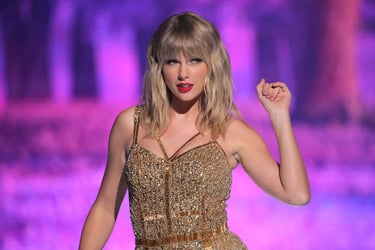GOSPEL OF GLITTER & GOLD: FEATURING TAYLOR & SWIFTIES
FRESH BREWSFEATURED
From $1,000 tickets to multi-million-dollar city boosts, Taylor Swift’s Eras Tour isn’t just a concert — it’s an economic phenomenon. This article breaks down how Swift turned nostalgia into pricing power, crafted scarcity into strategy, and gave entire local economies a shake-up with each stop on her tour. Welcome to the business model of a pop icon who knows her worth- and charges it. So what is the real cost of the Eras tour?


TAYLOR’S RISE TO CELEBRITY AND CURRENCY
There is something ceremonial, festive even when it comes to about 70,000 people chanting the name of a woman who, just hours before like any goddess, slips into a sequined bodysuit knowing full well she’s out to make history. She has no crown, yet they kneel with no wings as she dives into holographic stadium floors. None other than, ‘The Taylor Swift’. What she sells isn’t just music. It’s resurrection. And the altar? U.S Bank Stadium. MetLife. Wembley. Internet Socials. A global sensation of glittering images... However, in this article we shall delve into the status of her economic threshold, a tinge peek behind the scenes of her earnings, when the sequenced body suits are sold and her songs top charts endlessly.
OVERALL BRIEFING ON THE BEGINNING
Taylor Swift’s Eras Tour wasn’t merely a concert series. What began as a concert became communion. What was branded as a tour unraveled into an ‘Economic Era’ of its own. The Eras Tour did not just break records. It broke cities open. $2.2 billion in gross revenue. 4.35 million tickets sold worldwide by mid-2024. The average ticket price ballooned to $455 on resale platforms, some front-row seats reached $7,000+. Entire economies were rearranged to accommodate one night of catharsis. In the U.S. alone, it generated an estimated $5 billion in direct and indirect spending, enough to fund over 40,000 public school teachers for a year. Hotel occupancy rates jumped 30-45% in host cities. In Los Angeles, her six-night stint added $320 million to the local economy. Cities begged for her presence the way monarchs once begged prophets for visions. It was truly fascinating to see a socio-emotional commodity unfold, and most lucratively, a masterclass in pricing power at play behind the lit stages. The real show was not on stage for the world, it merely began with the numbers.
THE ECONOMIC APPROACH & BREAKDOWN
Swift’s team embraced dynamic pricing, a strategy in which ticket prices rise automatically based on real-time demand. In economic terms, they bet on her inelastic demand curve: the idea that no matter how high the price soared, her fans (Swifties) would still buy. Their guess? They were right. Primary tickets ranged from $49 to $449, but on resale markets like StubHub and Vivid Seats, front-row experiences exploded to over $7,000. The average resale ticket hovered at $455. This was Willingness to Pay (WTP) on frankly Induced Taylor Steroids (ITS). Taylor steroids was a term coined by many news outlets as a way to describe her ever growing potential which first started off as any minor career in a singers field. Only to turn out to be, the very drugs feeding a nation hell bent onto her voice, as this tour brought them back to those very memories of her earliest hits.
In cities she visited, consumer behavior mirrored festival economics. Hotels booked months in advance, local shops tailored products for Swift-themed surges, and some restaurants reported record-breaking evenings, even surpassing holidays. The emotional value outstripped the monetary price. Economists call this consumer surplus, when the experience is worth far more to the buyer than the amount paid. With Swift, it was pricelessness priced perfectly. Yet, in this fever dream of sequins and spending, a darker number slinked in beneath the basslines.
THE DEMAND AND SUPPLY CONFESSION
Supply and demand played out like a divine tragedy. Ticketmaster’s crash was a modern-day Babel tower, algorithms, bots and scalpers scrambling the line between fairness and chaos. To a point, Congress got involved.
Inside the stadium, however, inflation didn’t matter. Rent could wait. Tuition could rot. Marginal utility was thrown off the rooftop in rhinestone heels. Every song offered the same high as the last. It wasn’t just diminishing returns, it was infinite loopholes. People spent more than they had, willingly, because in the gospel of glitter, scarcity is holy. What we witnessed was not the invisible hand of the market but the manicured spread of sentiment, squeezing wallets dry for the lights on stage.
Up to 90 per show, hauled LED screens, sets, stages, and wardrobes from city to city. One stage alone used 1,200 moving lights. Multiply that by 150 shows. Add the fans flying in from 48+ countries. Then add the 40 tons of confetti. The environment bowed quietly under the weight of devotion, as if confessing they’d been the very currency people had come to watch in awe.
THE ALCHEMY OF EMOTIONS: PROFITS & LOSSES
Behind the sequins and serotonin, a subtler cost surfaced. Not environmental. Not financial, rather inspiring, evoking almost... spiritual. This wasn’t simple nostalgia, it was emotional arbitrage. She sold curated versions of the past and called them eras, each tied to a costume, a color, a lyric. Fans came dressed not as themselves, but as the selves they had once survived. The stadium became both a funeral and rebirth. And in that stadium, something strange occurred, Demand was eternal. Elasticity was irrelevant.
In glorifying these ideal versions of ourselves, the eras we loved, the exes we survived, the girls we were and the women we became, we also unearthed a strange kind of grief. It was joy mingling with mourning. People left the stadiums radiant and wrecked. There was a knowing look exchanged in the mirror that night: You can’t go back, but God, didn’t it feel like you almost could?
What the Eras Tour did, masterfully, was monetize memory. It taught cities how to pray with open wallets. It made economic miracles out of sentiment, grief, and glitter. And in doing so, it blurred the border between commerce and communion and common sense. At its core, this was not just about a singer reclaiming her narrative. It was about millions of people reclaiming their own, for a price.
The lights went out. The crowd wept. And somewhere backstage, some quietly tallied its losses, while others recounted profits. Why? Because grief is expensive and joy even more so when it’s dressed like closure. She made memory, feelings, personality, and nostalgia into a shot of booze only for a night. People paid at the bar, but god did she tend to them with so many tricks up her sleeve, it was impossible not to get drunk and have nothing in sight except the moment.
CLOSING CURTAIN, OPENING LEDGER
By the time the stage was packed into its final crate, the Eras Tour had proven one of the most explosive case studies in contemporary economics. It pushed the limits of dynamic pricing, redefined fan loyalty as financial currency, and revealed the extraordinary market potential of personal narrative.
It was capitalism, in simple terms, yes. But it came with a bridge that made you weep. Still, even cathedrals collapse under their own grandeur. The silence after the encore is not nothing. And some dreams, when purchased too dearly, do not return change.
The real cost of the Eras Tour may not be written on its balance sheet. It may lie in the echo of a stadium gone quiet, where 70,000 people once believed, daydreamed only for a night full of stars as it dawned on them, maybe the money was worth it entirely.
